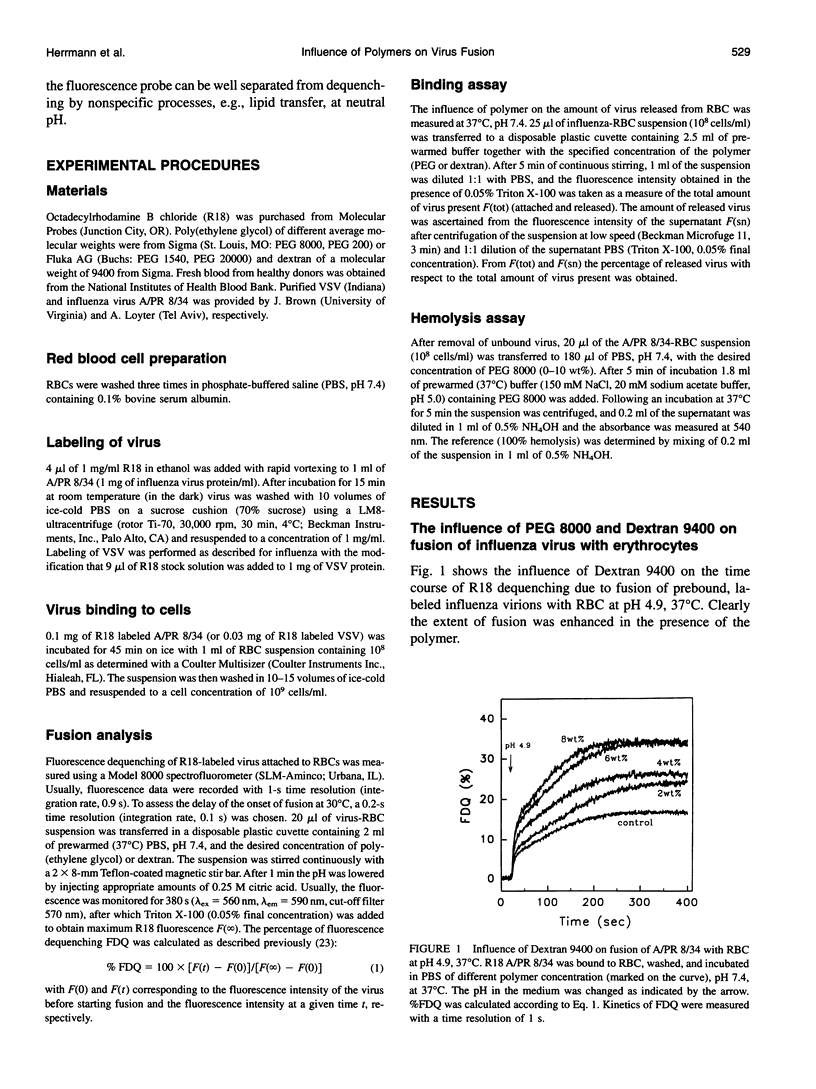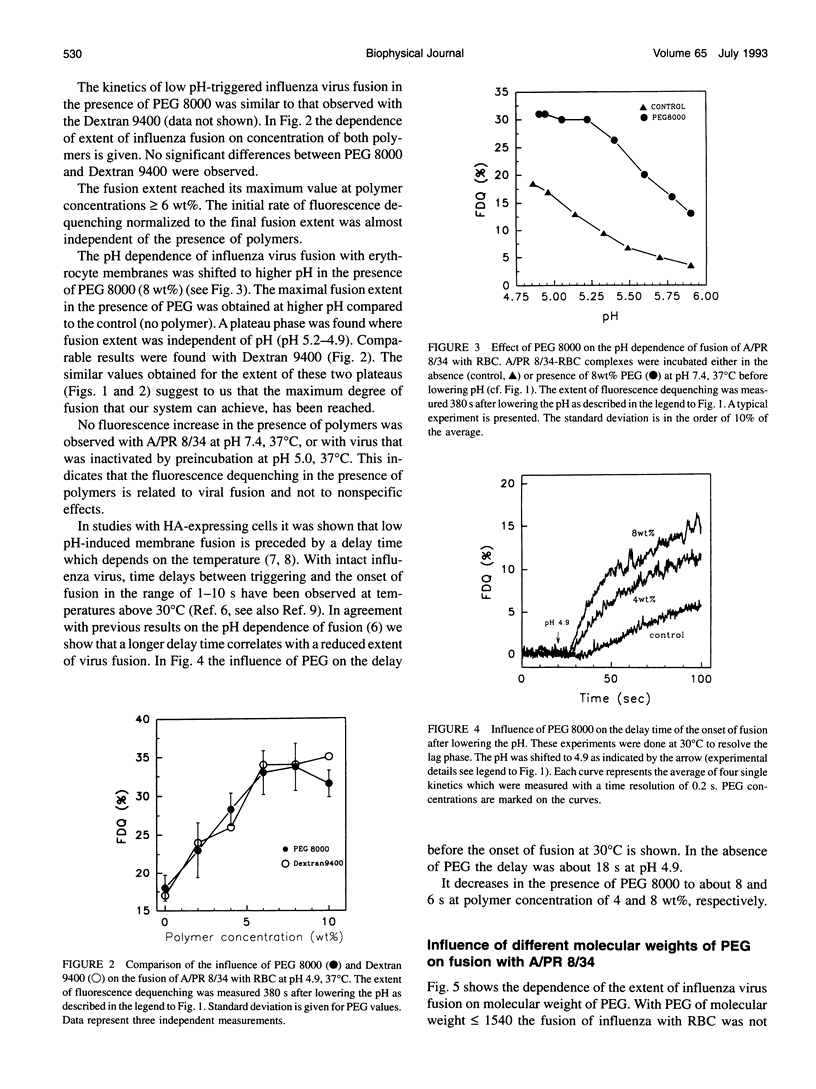Abstract
Nonadsorbing polymers such as dextran and poly(ethylene glycol) enhance binding as well as extents of fusion of influenza virus with erythrocytes. Kinetics and extent of viral membrane fusion were measured using an assay based on lipid mixing of a fluorescent dye. The effects of nonadsorbing polymers were in the concentration range from 0 to 10 wt%, far below the concentration required to overcome hydration repulsion forces. The enhancing effects were dependent on the molecular weight of nonadsorbing polymer, and only occurred at molecular weight > 1500; this links the phenomena we observe to the so-called "excluded volume effect" of nonadsorbing polymers. The time delay between triggering and the onset of influenza virus fusion was significantly reduced in the presence of nonadsorbing polymers. High molecular weight poly(ethylene glycol) also induced fusion of vesicular stomatitis virus with intact erythrocytes, which do not serve as target of vesicular stomatitis virus fusion in the absence of the polymer. The forces between membranes which determine rate-limiting processes in viral fusion and how they are affected by nonadsorbing polymers are discussed.
Full text
PDF






Selected References
These references are in PubMed. This may not be the complete list of references from this article.
- Arnold K., Zschoernig O., Barthel D., Herold W. Exclusion of poly(ethylene glycol) from liposome surfaces. Biochim Biophys Acta. 1990 Mar;1022(3):303–310. doi: 10.1016/0005-2736(90)90278-v. [DOI] [PubMed] [Google Scholar]
- Arnold K., Zschörnig O. Aggregation of human plasma low density lipoproteins by means of poly(ethylene glycol). Biomed Biochim Acta. 1988;47(12):949–954. [PubMed] [Google Scholar]
- Atha D. H., Ingham K. C. Mechanism of precipitation of proteins by polyethylene glycols. Analysis in terms of excluded volume. J Biol Chem. 1981 Dec 10;256(23):12108–12117. [PubMed] [Google Scholar]
- Bell G. I., Dembo M., Bongrand P. Cell adhesion. Competition between nonspecific repulsion and specific bonding. Biophys J. 1984 Jun;45(6):1051–1064. doi: 10.1016/S0006-3495(84)84252-6. [DOI] [PMC free article] [PubMed] [Google Scholar]
- Blumenthal R., Bali-Puri A., Walter A., Covell D., Eidelman O. pH-dependent fusion of vesicular stomatitis virus with Vero cells. Measurement by dequenching of octadecyl rhodamine fluorescence. J Biol Chem. 1987 Oct 5;262(28):13614–13619. [PubMed] [Google Scholar]
- Blumenthal R., Schoch C., Puri A., Clague M. J. A dissection of steps leading to viral envelope protein-mediated membrane fusion. Ann N Y Acad Sci. 1991;635:285–296. doi: 10.1111/j.1749-6632.1991.tb36499.x. [DOI] [PubMed] [Google Scholar]
- Clague M. J., Schoch C., Blumenthal R. Delay time for influenza virus hemagglutinin-induced membrane fusion depends on hemagglutinin surface density. J Virol. 1991 May;65(5):2402–2407. doi: 10.1128/jvi.65.5.2402-2407.1991. [DOI] [PMC free article] [PubMed] [Google Scholar]
- Clague M. J., Schoch C., Zech L., Blumenthal R. Gating kinetics of pH-activated membrane fusion of vesicular stomatitis virus with cells: stopped-flow measurements by dequenching of octadecylrhodamine fluorescence. Biochemistry. 1990 Feb 6;29(5):1303–1308. doi: 10.1021/bi00457a028. [DOI] [PubMed] [Google Scholar]
- Doms R. W., Helenius A., White J. Membrane fusion activity of the influenza virus hemagglutinin. The low pH-induced conformational change. J Biol Chem. 1985 Mar 10;260(5):2973–2981. [PubMed] [Google Scholar]
- Gallez D., Coakley W. T. Interfacial instability at cell membranes. Prog Biophys Mol Biol. 1986;48(3):155–199. doi: 10.1016/0079-6107(86)90011-8. [DOI] [PubMed] [Google Scholar]
- Gething M. J., Sambrook J. Cell-surface expression of influenza haemagglutinin from a cloned DNA copy of the RNA gene. Nature. 1981 Oct 22;293(5834):620–625. doi: 10.1038/293620a0. [DOI] [PubMed] [Google Scholar]
- Herrmann A., Arnold K., Pratsch L. The effect of osmotic pressure of aqueous PEG solutions on red blood cells. Biosci Rep. 1985 Aug;5(8):689–696. doi: 10.1007/BF01117001. [DOI] [PubMed] [Google Scholar]
- Herrmann A., Clague M. J., Blumenthal R. Role of target membrane structure in fusion with influenza virus: effect of modulating erythrocyte transbilayer phospholipid distribution. Membr Biochem. 1993 Jan-Mar;10(1):3–15. doi: 10.3109/09687689309150248. [DOI] [PubMed] [Google Scholar]
- Herrmann A., Clague M. J., Puri A., Morris S. J., Blumenthal R., Grimaldi S. Effect of erythrocyte transbilayer phospholipid distribution on fusion with vesicular stomatitis virus. Biochemistry. 1990 May 1;29(17):4054–4058. doi: 10.1021/bi00469a005. [DOI] [PubMed] [Google Scholar]
- Herrmann A., Pritzen C., Palesch A., Groth T. The influenza virus-induced fusion of erythrocyte ghosts does not depend on osmotic forces. Biochim Biophys Acta. 1988 Sep 1;943(3):411–418. doi: 10.1016/0005-2736(88)90372-0. [DOI] [PubMed] [Google Scholar]
- Hoekstra D., Klappe K., Hoff H., Nir S. Mechanism of fusion of Sendai virus: role of hydrophobic interactions and mobility constraints of viral membrane proteins. Effects of polyethylene glycol. J Biol Chem. 1989 Apr 25;264(12):6786–6792. [PubMed] [Google Scholar]
- Hoekstra D., de Boer T., Klappe K., Wilschut J. Fluorescence method for measuring the kinetics of fusion between biological membranes. Biochemistry. 1984 Nov 20;23(24):5675–5681. doi: 10.1021/bi00319a002. [DOI] [PubMed] [Google Scholar]
- MacDonald R. I. Membrane fusion due to dehydration by polyethylene glycol, dextran, or sucrose. Biochemistry. 1985 Jul 16;24(15):4058–4066. doi: 10.1021/bi00336a039. [DOI] [PubMed] [Google Scholar]
- Morris S. J., Sarkar D. P., White J. M., Blumenthal R. Kinetics of pH-dependent fusion between 3T3 fibroblasts expressing influenza hemagglutinin and red blood cells. Measurement by dequenching of fluorescence. J Biol Chem. 1989 Mar 5;264(7):3972–3978. [PubMed] [Google Scholar]
- Ohki S., Arnold K. Surface dielectric constant, surface hydrophobicity and membrane fusion. J Membr Biol. 1990 Apr;114(3):195–203. doi: 10.1007/BF01869214. [DOI] [PubMed] [Google Scholar]
- Pritzen C., Herrmann A. Are osmotic forces involved in influenza virus-cell fusion? Biosci Rep. 1988 Feb;8(1):55–64. doi: 10.1007/BF01128972. [DOI] [PubMed] [Google Scholar]
- Puri A., Winick J., Lowy R. J., Covell D., Eidelman O., Walter A., Blumenthal R. Activation of vesicular stomatitis virus fusion with cells by pretreatment at low pH. J Biol Chem. 1988 Apr 5;263(10):4749–4753. [PubMed] [Google Scholar]
- Sarkar D. P., Morris S. J., Eidelman O., Zimmerberg J., Blumenthal R. Initial stages of influenza hemagglutinin-induced cell fusion monitored simultaneously by two fluorescent events: cytoplasmic continuity and lipid mixing. J Cell Biol. 1989 Jul;109(1):113–122. doi: 10.1083/jcb.109.1.113. [DOI] [PMC free article] [PubMed] [Google Scholar]
- Schoch C., Blumenthal R., Clague M. J. A long-lived state for influenza virus-erythrocyte complexes committed to fusion at neutral pH. FEBS Lett. 1992 Oct 26;311(3):221–225. doi: 10.1016/0014-5793(92)81107-w. [DOI] [PubMed] [Google Scholar]
- Skehel J. J., Bayley P. M., Brown E. B., Martin S. R., Waterfield M. D., White J. M., Wilson I. A., Wiley D. C. Changes in the conformation of influenza virus hemagglutinin at the pH optimum of virus-mediated membrane fusion. Proc Natl Acad Sci U S A. 1982 Feb;79(4):968–972. doi: 10.1073/pnas.79.4.968. [DOI] [PMC free article] [PubMed] [Google Scholar]
- Spruce A. E., Iwata A., Almers W. The first milliseconds of the pore formed by a fusogenic viral envelope protein during membrane fusion. Proc Natl Acad Sci U S A. 1991 May 1;88(9):3623–3627. doi: 10.1073/pnas.88.9.3623. [DOI] [PMC free article] [PubMed] [Google Scholar]
- Stegmann T., Hoekstra D., Scherphof G., Wilschut J. Kinetics of pH-dependent fusion between influenza virus and liposomes. Biochemistry. 1985 Jun 18;24(13):3107–3113. doi: 10.1021/bi00334a006. [DOI] [PubMed] [Google Scholar]
- Stegmann T., White J. M., Helenius A. Intermediates in influenza induced membrane fusion. EMBO J. 1990 Dec;9(13):4231–4241. doi: 10.1002/j.1460-2075.1990.tb07871.x. [DOI] [PMC free article] [PubMed] [Google Scholar]
- Tilcock C. P., Fisher D. The interaction of phospholipid membranes with poly(ethylene glycol). Vesicle aggregation and lipid exchange. Biochim Biophys Acta. 1982 Jun 14;688(2):645–652. doi: 10.1016/0005-2736(82)90375-3. [DOI] [PubMed] [Google Scholar]
- White J., Kielian M., Helenius A. Membrane fusion proteins of enveloped animal viruses. Q Rev Biophys. 1983 May;16(2):151–195. doi: 10.1017/s0033583500005072. [DOI] [PubMed] [Google Scholar]
- Wu J. R., Lentz B. R. Mechanism of poly(ethylene glycol)-induced lipid transfer between phosphatidylcholine large unilamellar vesicles: a fluorescent probe study. Biochemistry. 1991 Jul 9;30(27):6780–6787. doi: 10.1021/bi00241a022. [DOI] [PubMed] [Google Scholar]
- Yamazaki M., Ohnishi S., Ito T. Osmoelastic coupling in biological structures: decrease in membrane fluidity and osmophobic association of phospholipid vesicles in response to osmotic stress. Biochemistry. 1989 May 2;28(9):3710–3715. doi: 10.1021/bi00435a013. [DOI] [PubMed] [Google Scholar]


